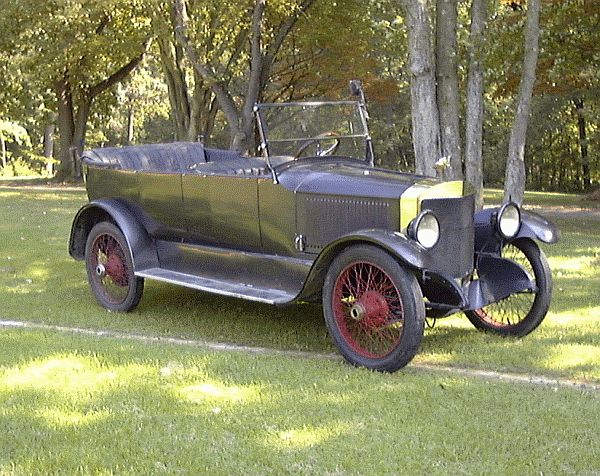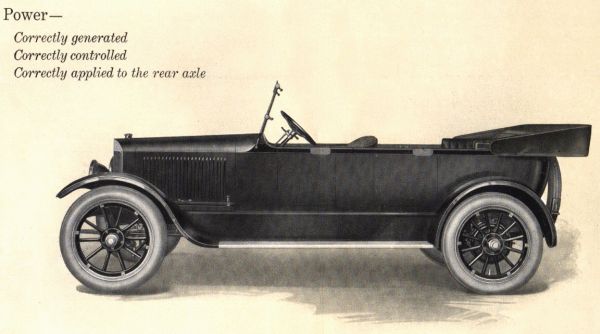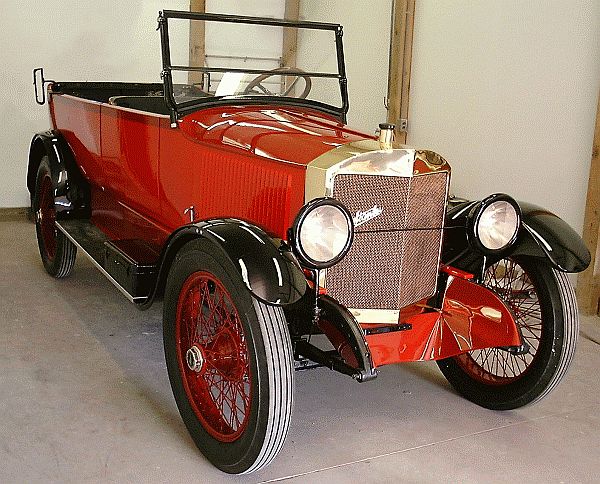|
Advertising literature for the 1918 Model 735 7-passenger Touring Stanley Steam Car indicated the standard factory color was Royal Green. The body would have been painted Royal Green with the fenders, splash guard (the metal fill panel between the running board and the lower body of the car at the floorboard), windscreen, headlights, and spare tire support hardware all painted a gloss black. A black top would finish off the body. Artillery wheels (wooden spoke wheels similar to those used on cannons of the time), which were the standard offering, would be painted Royal Green. For those wishing to pay extra for wire wheels, either red or white Hauk Wire Wheels were available. Stanley bodies had always been made by Currier Cameron Company and Shields Carriage Company. Both companies worked together since the early 1900s to fabricate first all wooden, and then aluminum over wood bodies for the full line of Stanley Steam Cars. Currier Cameron assembled the wooden components of the frame including the framework over which the aluminum sheetmetal would be formed. Then Carrier would take the frame and hand hammer the aluminum and sheetmetal panels over the frame to form the body. After painting with Valentine's Valspar Paints (Stanley advertized 24 hand applied coats of paint!) the complete body assembly was shipped toShields Carriage Company where the interior was installed. Once the interor was finished the body was shipped from Amesbury where Cameron and Shields were located to the Stanley factory where it could be dropped in place and bolted to the frame.
In 1915 when Stanley started offering condensing cars only, much of the brightwork was removed and only the brass condenser grille and nickel plated wheel hub nuts, hood latches, and wind screen bolts were bright. By this era car bodies were now able to be "dropped" within the wheelbase and thus cars of this era had lost their similarity to that of carriages. This period of automotive body styling is often thought of as drab and unexciting (remember that during this time Henry Ford had been pumping out cars in any color you wanted as long as it was black). During the 1950 through 1952 restoration of the car the body color was changed to gunmetal gray (an original Stanley color offering in later 735 models along with Cobalt Blue) with red wire wheels as pictured above. The replacement top was changed to tan. The fact that the car had been painted a rather dull shade of gray and sported a tan top further provided a "stuffy" image to the vehicle. A goal of the restoration would be to return the car to how Stanley originally painted the vehicles with only minor changes for the purpose of making the car more visually striking and exciting.
The starting point for figuring out how the car would be painted during the restoration was the 1918 sales literature for the Model 735. Pictured above is an artist's rendition of the car with artillery wheels. From the picture it is fairly easy to see that the fenders, splash guard, and windscreen are painted black. The body color is lighter than the black parts of the car thus indicating the body probably was painted Royal Green which would have been dark in color. Clearly visible in the picture (along with the Stanley "tag line" for their advertising) is a gloss black strip around the top of the body. The two light gray areas at the doors are protective leather pads that serve as door handles (note there is no external door latch hardware ~ the doors were opened only from the inside!). It is interesting to note in this drawing that the condenser shell also seems to be painted the same color as the body.
After discussions with a number of folks the color scheme shown above was decided upon. The color scheme remains true to Stanley tradition in that the fenders, spare tire support hardware, and windscreen are high gloss black. The body is painted a light shade of red matching the Light Red Valspar color available at this time. A color rendition of the car, using the Deep Red Valspar color for the wire wheels and black for the fenders and splash guard, soon raised concern that a light red hood might be too brilliant and perhaps too bold for the overall appearance of the car. After some discussion the rendition was modified to use the Deep Red Valspar color on the top panels of the hood which subdued the appearance to the desired degree. Changing the Stanley black band that framed out the top of the body to the Deep Red Valspar color allowed the Deep Red color of the hood to be tied into the body. The overall look of the car was coming together with one exception. Now the gloss black splash guard color was too prominent between the wheels of the car. A suggestion to change the splash guard color from the traditional black to the Deep Red Valspar color tied everything together and achieved the desired effect. Painting the "cow catcher" located underneath the brass condenser shell further set off the appearance of the car along with the traditional black windscreen. Finally a buckskin tan color was chosen as the pinstripe color used to highlight the openings on the hood side panels, to break the color change of Light Red to Deep Red around the top perimeter of the body, and to add some decorative accents to the wheels and windscreen. Originally the running boards would have been covered with dark gray linoleum as the drawing above indicates but a change to black linoleum was made in order to match the black linoleum of the front floorboards. The two shades of red of this web page along with the buckskin tan color which forms the frame for the discussion and black color of the text are very similar to the actual colors used on the car. |


